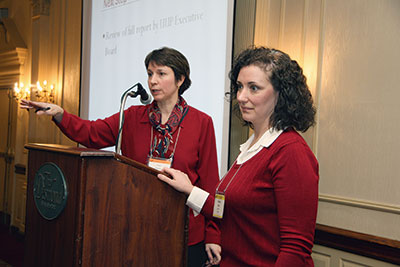| Here’s a news flash: female academics and professionals are paid less than their male counterparts. |
|
|
| Cortland UUPers Jamie Dangler, left, and Kathleen Burke answer questions on a preliminary study of gender inequity. |
|
Satire aside, an unexplained portion of the salary variation for academics—which is around $4,400—may be due to gender inequity, but cannot be solely attributed to that fact, according to a preliminary UUP study measuring salary inequity for academics and professionals in SUNY. Among professionals, salaries for employees in the lower pay grades varied only slightly. But females at pay grade five are paid more than 20 percent less than males, even though service years are similar. “I think we found a little more unexplained inequality than we’d thought we’d find,” said Jamie Dangler, a SUNY Cortland delegate who put together the study with Kathleen Burke, an associate professor of sociology at SUNY Cortland. “It gives us a very accurate picture of what’s happening, but it doesn’t explain why.” Dangler and Burke unveiled the preliminary study, titled “Gender Inequity,” at the Winter Delegate Assembly. More than 50 delegates, many of them women, listened to Dangler and Burke share preliminary results of the two-year study in detail and asked pointed questions about the report. The report studied potential salary inequities at Albany, Buffalo, Cobleskill, Cortland, Farmingdale, New Paltz and Plattsburgh, measuring years of service, rank, terminal degree and discipline- specific market salaries. It also includes information on focus groups, interviews and discussions about gender inequity with UUPers at 13 chapters. The study will be sent to the UUP Executive Board for review. Salary disparities For academics, females make $11,111 less in total salaries than males, on average. Of that, $6,617 is due to variables such as service, degree and rank. The question remains as to which factors best explain the remaining $4,494. “We tried, but we could not develop an adequate measure for productivity,” said Dangler, adding that an appendix dedicated to the team’s attempts to measure productivity is attached to the final report. In the study, “adjusted salaries”—total salary minus discretionary salary increases (DSI)—are taken into account. Using that measurement, there was a $10,405 difference in academics salaries at the schools surveyed. Of that, $4,306 is unattributable to measured variables and may be salary inequality, she said. DSI not a factor On average, DSI allocations for female academics were about the same—and in some cases higher—than those for males. For professionals, DSI for females were higher than males at all but the university centers, save for at professional studies schools. “The upshot of that is that DSI over time have not made a substantial difference,” Dangler said. “But we needed to check that.” For professionals, there was no consistent pattern in their salaries, other than professionals at the university centers—Albany and Buffalo—where males make more than females in the upper salary levels. The study also found that cost-of-living adjustments for all SUNY academics are not keeping pace with market trends—which take into account inflation and different market salaries dictated by academic disciplines—and that females are feeling the pinch more than males. For every $1 increase in market salaries for new assistant professors, SUNY?female professors got a 65-cent increase and male professors got a 70-cent increase. “A lot of what we found here is raising questions about what might need to be looked into further,” she said. Other findings of the study include: • Salaries for males seem to be consistently higher than female salaries, particularly in male-dominated engineering schools. • Librarians make less on average than other academics. • Male associate professors were promoted earlier than females in the first five years of service; females held a slight edge in years six through 10. It took almost twice as long for female associate professors at business schools to be promoted (5.1 years for males; 9.9 years for females). — Michael Lisi |
Warning: count(): Parameter must be an array or an object that implements Countable in /home/uuphos5/public_html/voicearchive/wp-includes/class-wp-comment-query.php on line 405


